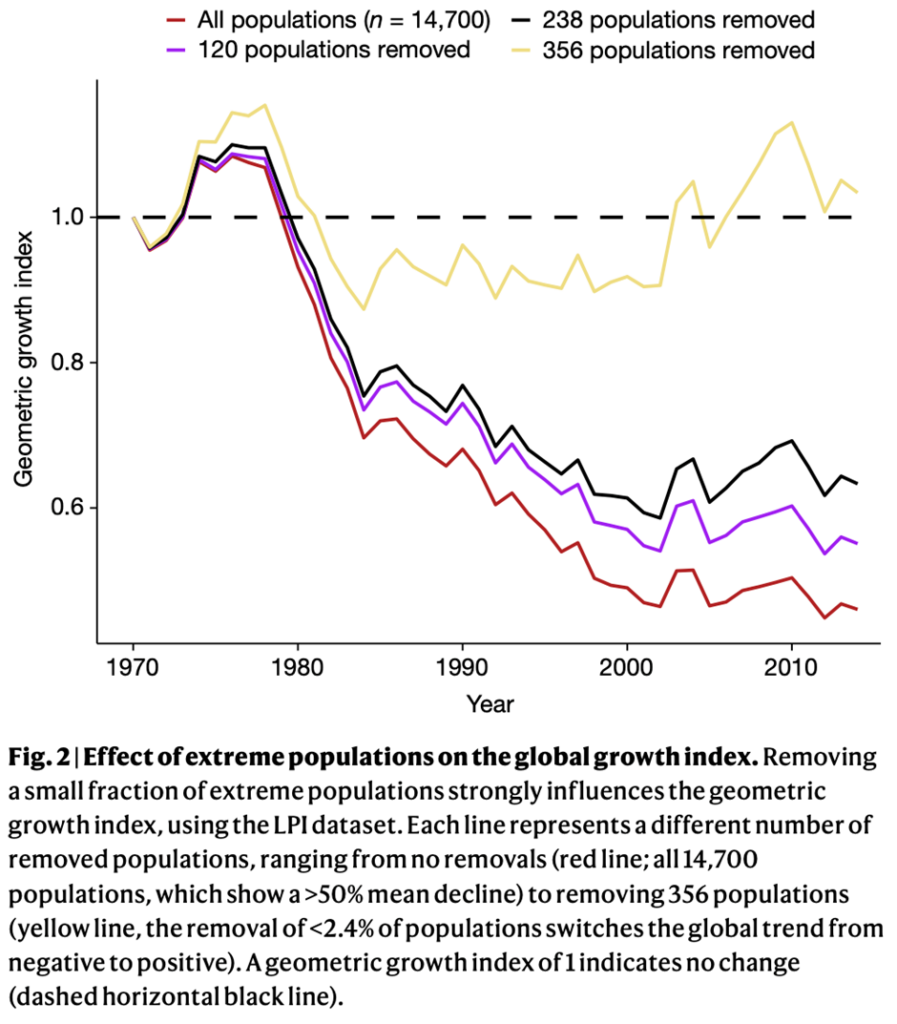Two independent groups of scientists have destroyed the always improbable claim that vertebrates across the planet have declined by 69% since 1970. The averaged claim is made by the World Wildlife Fund (WWF) and the Zoological Society of London (ZSL). It is a bedrock climate and ecological scare story repeated endlessly in the mainstream media and broadcast everywhere from UN platforms to school classrooms. A group of Canadian biologists have shown that the figure is a statistical freak. They reveal that the estimate is driven by 2.4% of wildlife populations, adding, “If these extremely declining populations are excluded, the global trend switches to an increase.”
The 69% scare is contained in the Living Planet Index (LPI) compiled by the WWF and the ZSL. The latest bi-annual report was released late last year to coincide with the COP15 Biodiversity Summit in Montreal, and claimed the decline was “an average fall in species population numbers between 1970 and 2018”. Commenting on its report, the ZSL said one million species of plants and animals are threatened with extinction. The joint report is said to have looked at 32,000 populations of animals from over 5,000 species.
The report is highly political, arguing for a complete transformation of society. The planet is said to be in the midst of a biodiversity and climate crisis, and we have a last chance to act. “A nature-positive future needs transformative – game changing – shifts in how we produce, how we consume, how we govern, and what we finance. We hope it inspires you to be part of that change,” say the authors. Less inspiring might have been the message that 2.4% of vertebrate populations are currently doing badly – it’s nature, it happens – but the rest on average are just dandy.
This latest debunking of a cherished green scare is further bad news for publicity-seeking climate catastrophists. Introducing the LPI report, the ZSL also noted that a 0.3°C warming would result in a loss of up to 90% of warm water coral, a scare that has a very ‘last decade’ look about it, given that corals on the Great Barrier Reef and elsewhere have rarely been in better shape. Slowly recovering Arctic ice, including the Greenland ice shelf, plateauing global surface temperature, and more polar bears hunting more seals, have all added to the recent misery.
The essence of the debunking scientists’ argument is that trying to distill disparate population trends into a single global index distorts the full picture. Calculating the straight line average across populations is strongly influenced by outliers, or extremes. For example, the biologists put forward a hypothetical scenario in which one animal population declining by 99%, while a second population increases 50 fold, or 393 populations increase by 1%. In this scenario, the geometric average – the metric used by the WWF and the ZSL – would show a catastrophic decline of 50%.

This work was done by the Canadian biologists before the last 2022 LPI report. The dotted line above indicates overall population stability. The red line shows a 50% decline averaged across all populations, but the removal of just 2.4% of separate populations produces a positive trend. The scientists observe that such clusters of decline require different conservation measures compared to widespread falls across the planet. But such a subtle understanding of focused conservation measures is entirely missing from the unhinged view spread throughout politics and the media that the planet and climate is under mortal threat, and urgent, collectivist Net Zero measures must be immediately implemented.
Accounting for extreme clusters “fundamentally alters the interpretation of global vertebrate trend”, say the scientists. The sensitivity of global average trends to outliers “suggests that more informative indices are needed”, they add.
Last month, a group of Finnish biologists joined the scientific fray over the Index and noted that statistical calculations prevented any straightforward interpretation in the change of animal abundance. The LPI measure is biased downwards because proportions are measured, not actual abundance. In fact, the more populations vary in their rate of increase or decrease, “the more downwardly biased the LPI will be as a measure of abundance”. Even worse, the scientists go on to show, the downward past bias is baked into future calculations, since previous index values are multiplied with the current one. Overall, the Finnish scientists take on board the outlier problems identified by the Canadians, but observe the trouble with the LPI methodology “is deeper than that and cannot be resolved by removing extreme population trends from the analysis”.
The LPI garners massive publicity and it is also used as an indicator for international negotiations within the UN Convention of Biological Diversity (CBD). “We urge scientists that have used the LPI methodology to scrutinise the conclusions of their work, and those negotiating future indicators for the UN CBD to critically review the interpretation of the LPI,” they conclude.
Chris Morrison is the Daily Sceptic’s Environment Editor.
Stop Press: Toby wrote about the methodological shortcomings of extinction predictions for the Spectator four years ago.












To join in with the discussion please make a donation to The Daily Sceptic.
Profanity and abuse will be removed and may lead to a permanent ban.